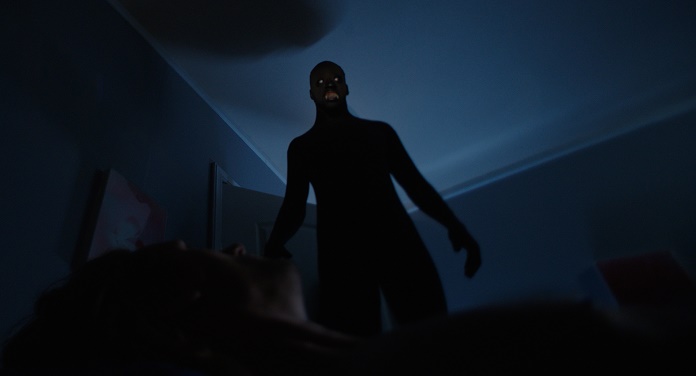
The Nightmare
Studio: Gravitas Ventures
Directed by Rodney Ascher
Jun 08, 2015
Web Exclusive
![]()
The talking heads in Rodney Ascher’s The Nightmare often start just outside of the room where the interview is being conducted. The camera sometimes literally peers around the corner, curiously and tentatively. If it’s a ploy for some sort of realism—for the camera to be an audience surrogate just as intrigued by the subject of sleep paralysis as Ascher—then fine. It works in its own way, contextually, even if it seems inessentially coy. In one of the first talking head interviews, with John F., you see the beginning of the take, clipboard and all. Oooh, verisimilitude!
The Nightmare is Ascher’s follow up to his debut feature documentary Room 237, which examined cinephilic obsession through the lens of several fanatics of Stanley Kubrick’s The Shining. It’s an interesting, if imperfect doc. But that film was only reliant on footage from the film, still images, etc. and the voices of the various interviewees. The Nightmare, in comparison, utilizes reenactments, as it were, of the various subjects’ nightmares. These all have rather the same, or similar, aesthetic: the plasticine shine of a person’s bedroom, its connotation of safety and security perverted by expressionistic lighting, the silhouettes of menacing figures. It is not unlike, unsurprisingly, a horror film. This safe haven disturbed by something unknown.
The specter is indeed intimidating, exacerbated by the film’s sound design. (The design reminds me vaguely of the demon in Post Tenebras Lux.) At least in theory. Recently, while I was watching Alex Gibney’s Mea Maxima Culpa: Silence in the House of God, I became infuriated at the director’s insistence to use reenactments in the film. The doc, which examines the systemic issue of child molestation in the Catholic Church, pulled what I felt was a bit of an unethical move: we have these (deaf) victims’ testimony, already harrowing. We don’t need anything else; it’s as if we’re treated as children. I thought back to Richard Brody’s screed “The Jinx and the Blight of Documentary Reenactments,” where he writes, “The reenactment is the bane and the curse of the modern documentary film—more so, even, than ominous-drone music… [They] aren’t what-ifs, they’re as-ifs, replete with approximations and suppositions that definitively detach the image from the event, the vision from the experience.” He is writing about Andrew Jarecki’s documentary series for HBO about Robert Durst, but he also examines the role of reenactments in Errol Morris’s The Thin Blue Line, which he argues are just as damning.
However, what is applicable to those aforementioned documentaries is not necessarily applicable to The Nightmare; those films are about specific events, things that happened in the tangible world. Murder, molestation, wrongful imprisonment. Ascher’s subject is much more theoretical, operating somewhere within the realm of the paranormal and the unconscious. I’m sure that most people would argue, Well, how else are you going to make a documentary about sleep paralysis? As Brody argues in his piece, the cinematic interview is such a piece of dramatic force that such reenactments, however fanciful they are in The Nightmare, are rather unnecessary.
It feels as if Ascher misses an opportunity to flex his creative arm beyond reenactments. To some degree, some congratulations is due inasmuch as the try at some surrealistic nightmare imagery. But we get glimpses at some of the illustrations certain subjects have made, artistic representations that articulate from a very specific point of view what it looks or feels like to be, in a word, trapped. Perhaps to use those drawings as a foundation would have alleviated the film of some of its hackier, even kitschier moments. Whatever dread is evoked by the interviewees is undercut by these reenactments, which seem so overtly cinematic in the worst way.
Maybe one could read the transparent nature of the creation of these scenes as this idea that the dreams are constructed movies. But the polished nature of them, the seemingly desperate attempt to horrify the audiences makes that reading feel a bit tenuous.
By using primarily play acted footage, it’s as if we, the audience, doubt these people, as if we need proof these things happened to them. That we need to hear a supposedly terrifying and computer manipulated voice bark “you know who I am” immediately after someone’s obviously frightened and bewildered testimony of the exact same thing is more terrifying than it should be. Ascher, intentionally or otherwise and like others before him, acts as if we can’t take them at their word. Now that’s a nightmare.
www.facebook.com/nightmaresleepparalysis
Author rating: 5/10
Average reader rating: 5/10
Current Issue

Issue #72
Apr 19, 2024 Issue #72 - The ‘90s Issue with The Cardigans and Thurston Moore
Most Recent
- Crumb Share Video for New Song “The Bug” and Announce New Tour Dates (News) — Crumb
- Sam Evian on “Plunge” (Interview) — Sam Evian
- Maya Hawke Shares Lyric Video for New Song “Hang in There” (News) — Maya Hawke
- Premiere: Anna Tivel Shares New Single “Desperation” (News) — Anna Tivel
- Nilüfer Yanya is a Runaway Bride in the Video for New Song “Like I Say (I runaway)” (News) — Nilüfer Yanya

Comments
Submit your comment
There are no comments for this entry yet.